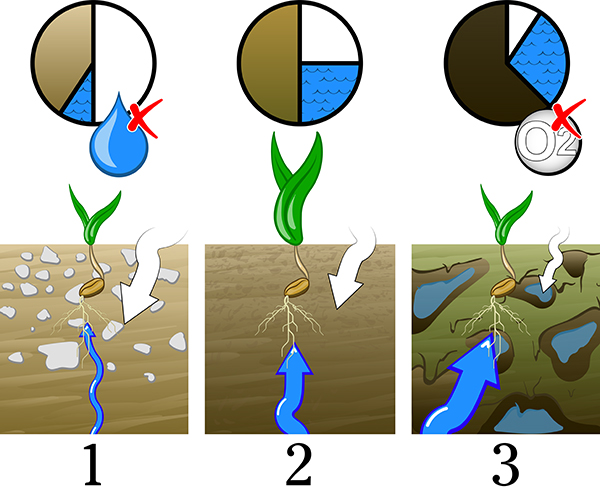The seedbed lays the foundations for crop establishment. However, there are different techniques that can be used to create a seedbed:
- Conventional technique
- Mouldboard ploughing + Rapid drilling
- Minimal tillage
- Ultra shallow tillage
- Shallow tillage
- Direct drilling
The technique used depends on many different factors, e.g. harvest residues, the equipment available, soil type, climate, labour requirement, etc.
Ploughing warms up the soil and buries plant residues so that they do not obstruct sowing. However, ploughing disrupts the soil structure and increases oxidation of the organic material. Without ploughing, the organic material and the soil structure are retained, but the straw can cause problems with sowing and can transmit diseases.

1. Conventional technique - ploughing in of straw, cultivation to sowing depth with a tine/disc cultivator, conventional drilling, fertiliser spreading.
2. Ploughing in of straw, shallow cultivation, drilling with Rapid where seed and fertiliser are placed in the soil simultaneously.

3. Minimal tillage – tillage of straw by cultivator, drilling with Rapid where seed and fertiliser are placed simultaneously in the soil/straw layer.
4. Shallow tillage – shallow burial of straw at the surface, drilling with Rapid where seed and fertiliser are placed simultaneously in the soil/straw layer.
5. Direct drilling – drilling with Rapid where seed and fertiliser are placed simultaneously without prior soil tillage. The straw remains on the surface.
Managing plant residues
An important difference between the techniques is how they manage plant residues. Plant residues affect the possibilities to achieve good contact between soil and seed. If there are large amounts of straw remaining, a great deal of tillage is required to ensure that the straw does not impede the next crop, but is broken down as efficiently as possible. The type of straw present, i.e. the precrop, determines how fast it decomposes and how effectively it can be handled by machinery.
Baled or buried
The straw can be baled and removed or buried in the soil. Decomposition of plant residues can improve the structure of a soil with poor structure. If the straw has an alternative value in animal production or for heating, it is often baled and collected in. This makes soil tillage easier in the short term. However, tillage may become more difficult in the long term if the amount of organic material decreases.
Ploughing sometimes justified
The choice of tillage technique can also be affected by the value of the following crop. If the crop can be sold at a high price, this can balance out the costs of ploughing if ploughing leads to better establishment. Another aspect to consider is the pressure from weeds and diseases. If there is a risk of transmission of disease, this can justify full inversion tillage. Difficult grass weeds may also need to be ploughed under. Finally, the ability of the machinery to handle large amounts of plant residues is another factor to consider.
Optimal reconsolidation
The aim of seedbed reconsolidation is to create good contact between seed and soil in order to provide an optimal supply of water, nutrients and oxygen to seeds and roots according to figure "Reconsolidation of the seedbed".
Too little reconsolidation, i.e. soil too loose around the seed, can lead to malfunction of capillary transport of water because the pores are too large. This means that the soil round the seed can become too dry. Too much reconsolidation means instead that the large pores are compressed and become less effective as regards draining away excess water and transporting oxygen to and carbon dioxide from the seed. This can lead to oxygen deficiency for the roots. On lighter soils (medium and fine sand), light machinery has the best effect, whereas heavy clays need heavier machinery to cultivate and reconsolidate the soil.
Reconsolidation of the seedbed
Soil consists of around 50% solid material, with 50% pores. In the ideal case, half the pores are filled with water, half with air. However this varies widely depending on how much rain has fallen, the structure of the soil and how it is tilled.

- Too little reconsolidation, i.e. soil too loose around the seed, can prevent capillary transport of water because the pores are too large. This means that the soil around the seed becomes too dry, so the seed dries out and the seedling wilts.
- Optimal reconsolidation provides good contact between seed and soil, so the seed is supplied with water through capillary transport. At the same time, there are enough large pores to transport oxygen.
- Too much reconsolidation means in contrast that the large pores are compressed and become less effective as regards draining away excess water and transporting oxygen to and carbon dioxide from the seed. This can lead to oxygen deficiency, which kills the roots.
Dictionary:
Capillary = water that can rise upwards in the soil within the fine pores through binding of the water molecules in the pores, adhesion, but also through attraction between water molecules, cohesion. Silty soils have high capillarity and combine a large height of capillary rise with a high rate of capillary rise
Precrop = the precrop is the crop grown before the present growing season, i.e. the previous year’s crop, and it affects the current year’s crop through the amount of residues it leaves, the nitrogen release from these, soil structure, disease pressure, etc


